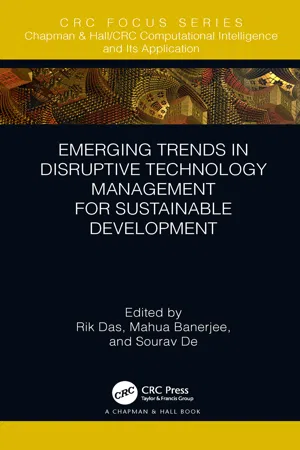
Emerging Trends in Disruptive Technology Management for Sustainable Development
- 120 pages
- English
- ePUB (mobile friendly)
- Available on iOS & Android
Emerging Trends in Disruptive Technology Management for Sustainable Development
About This Book
Interdisciplinary approaches using Machine Learning and Deep Learning techniques are smartly addressing real life challenges and have emerged as an inseparable element of disruption in current times. Applications of Disruptive Technology in Management practices are an ever interesting domain for researchers and professionals. This volume entitled Emerging Trends in Disruptive Technology Management for Sustainable Development has attempted to collate five different interesting research approaches that have innovatively reflected diverse potential of disruptive trends in the era of 4 th. Industrial Revolution. The uniqueness of the volume is going to cater the entrepreneurs and professionals in the domain of artificial intelligence, machine learning, deep learning etc. with its unique propositions in each of the chapters. The volume is surely going to be a significant source of knowledge and inspiration to those aspiring minds endeavouring to shape their futures in the area of applied research in machine learning and computer vision.
The expertise and experiences of the contributing authors to this volume is encompassing different fields of proficiencies. This has set an excellent prelude to discover the correlation among multidisciplinary approaches of innovation. Covering a broad range of topics initiating from IoT based sustainable development to crowd sourcing concepts with a blend of applied machine learning approaches has made this volume a must read to inquisitive wits.
Features
-
- Assorted approaches to interdisciplinary research using disruptive trends
-
- Focus on application of disruptive technology in technology management
-
- Focus on role of disruptive technology on sustainable development
-
- Promoting green IT with disruptive technology
The book is meant to benefit several categories of students and researchers. At the students' level, this book can serve as a treatise/reference book for the special papers at the masters level aimed at inspiring possibly future researchers. Newly inducted PhD aspirants would also find the contents of this book useful as far as their compulsory course-works are concerned. At the researchers' level, those interested in interdisciplinary research would also be benefited from the book. After all, the enriched interdisciplinary contents of the book would always be a subject of interest to the faculties, existing research communities and new research aspirants from diverse disciplines of the concerned departments of premier institutes across the globe. This is expected to bring different research backgrounds (due to its cross platform characteristics) close to one another to form effective research groups all over the world. Above all, availability of the book should be ensured to as much universities and research institutes as possible through whatever graceful means it may be.
Hope this volume will cater as a ready reference to your quest for diving deep into the ocean of technology management for 4 th. Industrial Revolution.
Frequently asked questions
Information
1
IoT-Based Intelligent System for Identification of Plant Stress in Sustainable Agriculture
Debarshi Mazumder , Sudarshan Nandy, and Sudip Chatterjee
CONTENTS
1.1 Introduction
1.2 Organization of IoT

- Layer 1: Perception Layer—In the agriculture sector, this layer consists of numerous sensors and cameras. Different types of sensors and cameras are collecting various types of raw data from the agriculture field. Agriculture field sensors are collecting data related to humidity, ...
Table of contents
- Cover
- Half-Title
- Series
- Title
- Copyright
- Dedication
- Contents
- Preface
- Editors
- Contributors
- 1 IoT-Based Intelligent System for Identification of Plant Stress in Sustainable Agriculture
- 2 IoT: A step Towards Sustainability
- 3 Smartphone Crowd Computing: A Rational Approach for Sustainable Computing by Curbing the Environmental Externalities of the Growing Computing Demands
- 4 CFD-Based Flow Analysis around the Multi-Body Segments Optimized Using Rigid Body Fitting Method for Robotic Fish Design
- Index